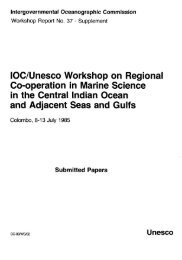Manual on sea level measurement and ... - unesdoc - Unesco
Manual on sea level measurement and ... - unesdoc - Unesco
Manual on sea level measurement and ... - unesdoc - Unesco
- No tags were found...
You also want an ePaper? Increase the reach of your titles
YUMPU automatically turns print PDFs into web optimized ePapers that Google loves.
Sea Level Measurement <strong>and</strong> Interpretati<strong>on</strong>instrument c<strong>on</strong>nected into this supply tube at thel<strong>and</strong>ward end records the changes in water <strong>level</strong> aschanging pressures, according to the law:h=(p-p a )/(ρg)where hpp aρg= height of <strong>sea</strong> <strong>level</strong> above the bleed hole= measured pressure= atmospheric pressure= <strong>sea</strong>water density= gravitati<strong>on</strong>al accelerati<strong>on</strong>Most pneumatic instruments use a pressure sensoras part of the recording equipment to m<strong>on</strong>itor thechanges in pressure <strong>and</strong> hence <strong>sea</strong> <strong>level</strong>. It is comm<strong>on</strong>to use a sensor operating in the differential mode, sensorsbeing so c<strong>on</strong>structed that the system pressure isopposed by atmospheric pressure. Hence, the resultantpressure experienced by the sensor becomes (p–p a ),making the measured pressure directly proporti<strong>on</strong>al tothe required <strong>sea</strong> <strong>level</strong>.A knowledge of the <strong>sea</strong>water density (ρ) is important.This is normally obtained from separate watersampling, <strong>and</strong>, where the water is well mixed, can bec<strong>on</strong>sidered c<strong>on</strong>stant. In estuarine locati<strong>on</strong>s, the densitymay change during a tidal cycle or <strong>sea</strong>s<strong>on</strong>ally, <strong>and</strong>density correcti<strong>on</strong>s will have to be included in the dataprocessing.Several other effects <strong>on</strong> the measured pressure haveto be c<strong>on</strong>sidered. These include a ‘static’ effect, whichis a functi<strong>on</strong> of the height of the gauge above <strong>sea</strong><strong>level</strong>, <strong>and</strong> a ‘dynamic’ effect, which results from thedynamics of gas flow. The latter can be calculated interms of tube length <strong>and</strong> radius <strong>and</strong> the minimumair-flow c<strong>on</strong>sistent with preventing water from enteringthe system (Pugh, 1972). The effect of waves <strong>on</strong>the system is to introduce a positive bias during stormc<strong>on</strong>diti<strong>on</strong>s (i.e. <strong>sea</strong> <strong>level</strong> is measured too high). Theseeffects can perturb the <strong>sea</strong> <strong>level</strong> <strong>measurement</strong>s at thesub-centimetre <strong>level</strong> during average c<strong>on</strong>diti<strong>on</strong>s, but<strong>measurement</strong>s may be incorrect by several centimetresunder extreme waves.In comm<strong>on</strong> with all pressure measuring systems, thereis a need to establish a datum for the observed timeseries. This can be achieved in several ways: (a) froma knowledge of the exact depth of the pressure pointbleed hole during installati<strong>on</strong>, combined with accuratecalibrati<strong>on</strong> of the pressure transducer; (b) using datum<strong>level</strong> switches similar to those described above forstilling wells which trigger at a known <strong>sea</strong> <strong>level</strong>; (c) byhaving a parallel system (called a ‘B’ gauge; secti<strong>on</strong>3.3.4) with a sec<strong>on</strong>d <strong>and</strong> more accessible pressurepoint fixed near mean <strong>sea</strong> <strong>level</strong>. Comparis<strong>on</strong> of the differencesbetween the two bubbling systems when bothare submerged gives an accurate measure of the datum;method ‘c’ is the most accurate.Air is normally supplied to a bubbler from a compressorto afford c<strong>on</strong>tinuous operati<strong>on</strong> of the installati<strong>on</strong>. In theevent of electrical supply failure, a reserve air capacitycapable of sustaining the system for at least several daysis necessary. For sustained operati<strong>on</strong> under fault c<strong>on</strong>diti<strong>on</strong>s,an alternative low power backup system in theform of a pressure transducer mounted directly in the<strong>sea</strong> is necessary. Transducers, compressors, data loggersetc. can be purchased from the major gauge manufacturerswith ready-to-go packages. An all-bubbler systemhas an advantage that most comp<strong>on</strong>ents are underwater,<strong>and</strong> that all comp<strong>on</strong>ents are both robust <strong>and</strong>, ifdamaged, relatively inexpensive to replace.3.3.2 Pressure Sensor GaugesPressure sensors can be fixed directly in the <strong>sea</strong> tom<strong>on</strong>itor sub-surface pressure in a similar fashi<strong>on</strong> to thebubbler gauge. The sensor is c<strong>on</strong>nected by a cable thatcarries power <strong>and</strong> signal lines to an <strong>on</strong>shore c<strong>on</strong>trol<strong>and</strong> logging unit. In the <strong>sea</strong>, the active sensor is usuallyc<strong>on</strong>tained within a copper or titanium housing withthe cable entering through a watertight gl<strong>and</strong>. Materialused for the housing is chosen to limit marine growth.The assembly is c<strong>on</strong>tained in an outer protective tubeto provide a stable fixati<strong>on</strong> to a <strong>sea</strong> wall or rock outcrop.Where this is not possible, the pressure sensormay be placed securely <strong>on</strong> the <strong>sea</strong> bed, but this methodhas disadvantages, as deployment <strong>and</strong> maintenanceusually require a diving team.Pressure-based instruments can be operated from batteriesfor periods of a year or more, as they c<strong>on</strong>sumea very small amount of power. This can be advantageouseven where electrical supplies are available butsubject to l<strong>on</strong>g periods of failure. Therefore, they havebeen used extensively in remote areas, such as oceanicisl<strong>and</strong>s, where access is limited. In polar regi<strong>on</strong>s, theyoffer the best alternative if the area is ice covered or ifthe gauge is to be left unattended for l<strong>on</strong>g periods. Themain disadvantage is the lack of a fixed datum <strong>level</strong>,which has to be found by alternative means.Pressure sensors are available in two varieties thatprovide either an absolute or differential signal. If anabsolute transducer is employed, the sensor provides a<strong>measurement</strong> of the total pressure including <strong>sea</strong> <strong>level</strong><strong>and</strong> atmosphere. Therefore, a separate barometer isrequired usually in the form of an identical transduceropen to the atmosphere. Both sensors are synchr<strong>on</strong>izedto the same clock so they can readily be subtracted toyield <strong>sea</strong> <strong>level</strong> (with subsequent correcti<strong>on</strong> for density<strong>and</strong> accelerati<strong>on</strong> due to gravity). Differential pressuretransducers have a vented cable in which the referenceside of the transducer is open to the atmosphere.Vented systems are known to suffer from occasi<strong>on</strong>alblockage <strong>and</strong> are used less frequently in hazardousenvir<strong>on</strong>ments. In additi<strong>on</strong>, a record of barometric pressureis valuable for oceanographic studies, so the twotransduceropti<strong>on</strong> is most frequently employed.14IOC <str<strong>on</strong>g>Manual</str<strong>on</strong>g>s <strong>and</strong> Guides No 14 vol IV
















